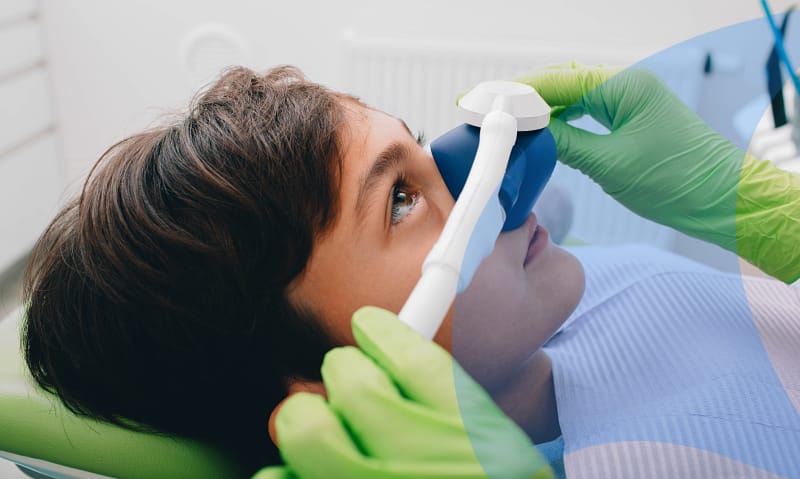Sedation Dentistry: 3 Fast Facts

Transform your child’s dental procedure experience.
As a parent, it goes without saying that you want what’s best for your child. So when your child needs to undergo a dental procedure, it’s completely natural to worry about how they will handle it. You may be concerned that your child will be afraid, won’t sit still during the procedure, or won’t listen to their dentist’s instructions. Almost every parent we talk to shares these same worries. Thankfully, this is one of the major benefits to taking your child to a pediatric dental specialist. Pediatric dentists and their staff work with children all day, every day, so they know a wide range of tried-and-true techniques to help your child throughout their procedure. Dr. Cooper and Dr. Day use these techniques to ensure your child’s treatment goes smoothly and remains a positive experience.
If your child needs to undergo a lengthy procedure or has severe dental anxiety, however, they may need a little more help to keep them calm and still throughout the procedure. In these cases, sedation dentistry may be a good option. Complications from sedation are very rare, but they can happen, so we never suggest using it unless we believe your child could benefit from it. We want you to be confident in your decision, however, so don’t be afraid to take the time to discuss all of your options with your child’s dentist before deciding whether or not to use sedation dentistry. Sedation isn’t necessary for every procedure, but when it is necessary, it can make all the difference for your child. To help you understand sedation dentistry and how it may help your child, we’ve decided to share 3 fast facts.
1. What is conscious sedation dentistry?
Conscious sedation is a method used by dentists to keep patients relaxed and comfortable throughout their procedure. Dentists can use a wide range of medicines to accomplish conscious sedation, including a mild oral sedative or nitrous oxide, which is commonly called laughing gas. Patients who are under conscious sedation are awake and can respond to their dentist’s questions or directions but feel very relaxed and aren’t in any pain.
2. What will sedation dentistry be like for my child?
A range of medications are used to produce varying levels of conscious sedation, but the goal is always to ensure your child feels calm and relaxed instead of anxious or antsy. Nitrous oxide, which is often used for conscious sedation in children, will relax your child and often causes feelings of happiness or euphoria. So don’t worry; conscious sedation ensures your little one won’t be distressed during their procedure. Nitrous oxide takes effect and wears off in just a few minutes. In fact, adults who undergo procedures with nitrous oxide are usually able to drive themselves home after waiting a few minutes for the gas to wear off.
In some cases, an oral medication may be given instead to produce a greater level of sedation. This can cause your child to feel relaxed and sleepy. They may slur their words slightly but will stay awake and aware enough throughout the procedure to listen to their dentist’s directions or answer questions. When this level of conscious sedation is reached, they may not remember the procedure well. Whether your child is getting a dental filling or a different procedure, they won’t feel any pain during the procedure.
Depending on the medication that is used and your child’s individual response to it, they may feel nauseous as it begins to wear off. You can check with Dr. Cooper or Dr. Day beforehand about what medications you can give your child for potential nausea. Other than this, though, recovery is usually a simple matter of waiting for the medication to wear off and paying attention to how your child is feeling.
3. Is anesthesia or sedation dentistry better for your child’s dental work?
Choosing between anesthesia and conscious sedation depends heavily upon what treatment your child needs. Anesthesia may be better when your child needs more extensive or lengthy dental work that they may be unable to tolerate, even with conscious sedation. This could include a procedure like a root canal and the placement of a dental crown or a tooth extraction. Using general anesthesia for a dental procedure carries the same risks it does when it’s used for surgery and must be completed by a pediatric dentist with the right qualifications.
While negative outcomes don’t occur very often from general anesthesia, it’s still important to consider it carefully with Dr. Cooper or Dr. Day before you decide on it as the best course of action.
Make your child’s dental procedure a tolerable experience.
Building positive experiences at the dentist can encourage your child to approach dental care and procedures with confidence, even as they grow into adults! Pediatric dentists use a range of methods to accomplish this, but in some cases, sedation dentistry may be the key to helping your child’s procedure go more smoothly for everyone. If you’d like to learn more about sedation dentistry from a pediatric dentist in Salem, Oregon, feel free to call our office and schedule a consultation at any time.